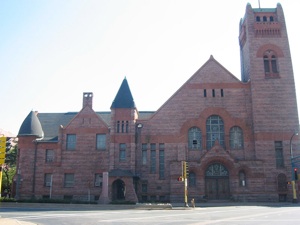|
Builder: John Eric Bergstrom (1892) Originally E. & G. G. Hook Opus 468 (1868) Manuals: 3 Stops: 36 (44 reported in newspaper) Ranks: 41 Action: Tubular Pneumatic Notes: The Centenary Methodist congregation built this new building in 1891 and changed its name to Wesley Methodist Episcopal Church. The interior of the auditorium is a modified Akron design with curved pews and a thrust stage in the corner. The facade of the organ is behind the stage. The original Hook organ is believed to have been the basis of the enlargement when the congregation moved to this church. The 1892 organ was built by Swedish immigrant John Bergstrom (1826-1907). Bergstrom had settled first in New York in 1850, worked for William B. D. Simmons (founded in 1860) in Boston, and moved to San Francisco in 1864. He established his own company in about 1875 and relocated to Minneapolis in 1891. Believing there wasn't enough work in Minneapolis, he returned to San Francisco in 1893. The Wesley organ is believed to be his only work in the Twin Cities during those 2-3 years. Bergstrom set up his factory in late 1891/early 1892 at 1627-29 5th St. S. E. Vice President was J. Lewis Browne, organist at Immaculate Conception. Sons James and Hector worked there. Total employment was 15 men. They had orders for 5 organs, of which Wesley was the largest at 44 stops and a cost of $7000. Bergstrom may well have used a large builder, such as Hook, for the substantial enlargement, applying his own name (although with a staff of 15 they certainly could have done most of the work themselves). The current facade stylistically dates from around the turn of the century, so it is likely this is the only remaining work directly attributable to Bergstrom. The wooden base could be from the original Hook, although since the original organ was not large and was located in a corner, the existing woodwork probably dates from Bergstrom. Information and photo from Wikipedia, Organ Historical Society, Minneapolis Tribune, Charles Hendrickson, Bill Van Pelt, Alan Laufman, David H. Fox, Jim Lewis, and David Engen. Last update 09/2017 |
 |
 |
|
|
GREAT ORGAN 16' Open Diapason 8' Open Diapason 8' Gamba 8' Dulciana 8' Doppelflöte 4' Harmonic Flute 2-2/3' Twelfth 2' Fifteenth Mixture IV 8' Trumpet |
SWELL ORGAN 16' Bourdon 8' Open Diapason 8' Salicional 8' Stopped Diapason 8' Quintadena 4' Waldflöte 2' Flautino Cornet III 8' Vox Humana 8' Bassoon 8' Cornopean Tremolo |
|
CHOIR ORGAN 8' Open Diapason 8' Melodia 8' Dulciana 4' Principal 4' Fugara 4' Flute d'Amour 2' Piccolo 8' Clarinet |
PEDAL ORGAN 16' Open Wood Diapason 16' Subbass 8' Octave 8' Violoncello 4' Principal Bass 16' Posaune |
| Note: There are tonal similarities to the Johnson organ of 1877 at Mankato and the Steere & Turner of 1875 at First Baptist in St. Paul |